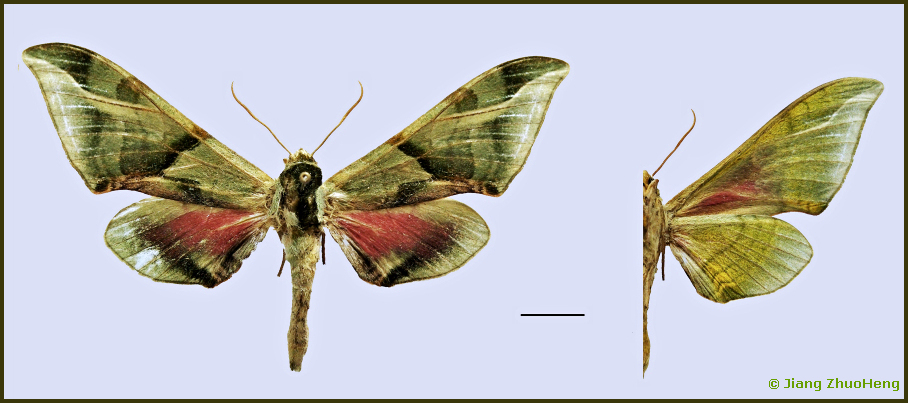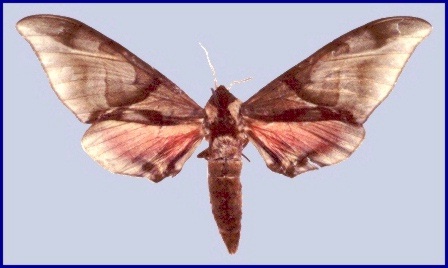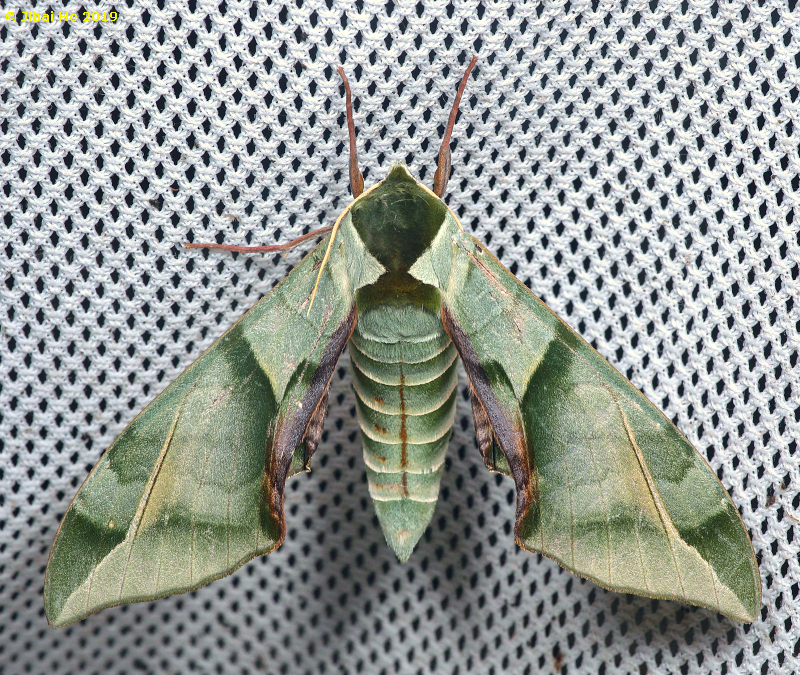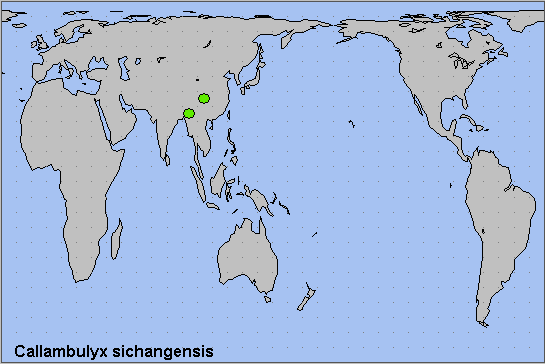

Callambulyx tatarinovi [sic] sichangensis Chu & Wang, 1980, Acta zootaxon. sin. 5: 418. Type locality: China, Sichuan, Xichang, Lushan.
Note. In the original description of Callambulyx tatarinovi [sic] sichangensis, Chu & Wang (1980) used the specific epithet sichangenata in the heading to the descriptive text (p. 418) but sichangensis elsewhere in the work, in the legend to figure 1 (p. 418), in the legend to plate 1 (p. 424) and in the heading of the description in English (p. 425). This is a case of multiple original spellings, and the correct name must be determined by the application of the Principle of the First Reviser. Shortly after publication, Chu & Wang (1980: 46) referred to the taxon as Callambulyx tatarinovi sichangensis and so under Article 24.2.4 of the Zoological Code are deemed to have acted as First Revisers and fixed sichangensis as the correct name of the taxon. Under Article 19.3 of the Code, sichangenata is deemed to be an incorrect original spelling and not separately available. Subsequently, Inoue (1990: 1) incorrectly treated sichangenata as the correct name for the taxon when synonymizing it with Callambulyx poecilus poecilus.
Eitschberger & Nguyen (2018) claimed that sichangenata was the valid name based on "page priority" ["Seitenpriorität"] and that sichangensis was either an incorrect spelling or unjustified emendation "if we do what the rules of the ICZN require" ["wenn wir das tun, was die Regeln der ICZN vorschreiben"]. However, as noted above, the correct application of the Code (Article 24.2.4) requires that the name sichangensis be accepted as the valid name for the taxon.
Note. This taxon has been treated either as a subspecies of Callambulyx tatarinovii (e.g. Zhu & Wang, 1997) or as a synonym of C. poecilus/diehli (e.g. Inoue, 1990). However, after examination of the holotype, and two specimens in the collection of J.-M. Cadiou from Dianchang Shan, Yunnan, we concluded that C. sichangensis is a species separate from both C. poecilus/diehli and C. tatarinovii. The most characteristic feature of C. sichangensis is the dark-green 'V'-shaped mark on the forewing, contrasting strongly with the paler green areas surrounding it. This pattern element is present in both C. poecilus/diehli and C. tatarinovii but is not so conspicuous. The distal margin of this mark is smoothly concave in C. sichangensis, whereas it is irregular or serrate in the other two species. There is also a long white line extending basad from the apex of the forewing in C. sichangensis that is visible on both wing surfaces, similar to that seen in C. sinjaevi Brechlin, but is not as strongly developed. This line is very poorly developed or absent in C. poecilus/diehli and C. tatarinovii. C. sichangensis also differs in wing shape and the pattern of lines on the hindwing underside. There are also diagnostic features of the male genitalia of C. sichangensis. The uncus of C. poecilus/diehli is laterally compressed and produced apically into a broad, triangular, blunt point, whereas the uncus of C. tatarinovii is slender, tubular and has a rounded apex. In contrast, the uncus of C. sichangensis is flared apically into two flanges, between which is a deep notch (see Zhu & Wang, 1997: fig. 203). The shape of the valve and harpe are generally similar in C. sichangensis and C. poecilus/diehli. Both species have a blunt lobe on the inner surface of the valve, which is absent in C. tatarinovii. However, in C. poecilus/diehli this lobe is in the middle of the valve, whereas in C. sichangensis, it is on the ventral edge of the valve, behind the harpe. From the base of this lobe in C. poecilus/diehli there extends a narrow, sclerotized ridge bearing a few peg-like setae. In C. sichangensis, this ridge is expanded ventrally into a triangular bulge with numerous peg-like setae. There are also other differences, such as the shapes of the juxta and valve apex, and the length of the saccus. The phallus of C. poecilus/diehli is longer than that of C. sichangensis, and the diverticula of the vesica are bluntly triangular in shape in the former, whereas those of the latter are broadly rounded. Finally, C. poecilus/diehli and C. sichangensis co-occur, at least on Diancang Shan in Yunnan.
Very similar in both shape and colour to Callambulyx tatarinovii formosana Clark, 1935 from Taiwan. However, just like in that subspecies and other species of Callambulyx, all green adult colouration can fade to brown or grey.


Unknown.
China: 16.v (Simian Mountain National Scenic Resort, Chongqing); vi (Maipu); vii (Diancang Shan, near Dali; Dabaoshan; Luojishan, Xichang); 4.viii (Lushan); 20.viii (Kunming).
OVUM: Unknown.
LARVA: Unknown.
PUPA: Unknown.
Larval hostplants. Unknown.
Unknown.
China: Sichuan (Lushan; Maipu; Luojishan, Xichang); Chongqing (Simian Mountain National Scenic Resort, 1060m); Yunnan (Diancang Shan, near Dali; Gaoligong Shan; Dabaoshan, Huaping; Kunming; Deqing/Dêqên County, Diqing Tibetan Autonomous Prefecture/Dêqên Autonomous Prefecture; Wenshan Zhuang and Miao Autonomous Prefecture).
Endemic to China.

Holarctic; eastern Palaearctic region. Pleistocene refuge: Monocentric -- Yunnan refugium.
 Return to Sphingidae of the Eastern Palaearctic species list
Return to Sphingidae of the Eastern Palaearctic species list